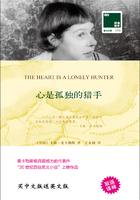Although New York often imparts a feeling of great forlornness or forsakenness, it seldom seems dead or unresourceful; and you always feel that either by shifting your location ten blocks or by reducing your fortune by five dollars you can experience rejuvenation. Many people who have no real independence of spirit depend on the city' s tremendous variety and sources of excitement for spiritual sustenance and maintenance of morale. In the country there are a few chances of sudden rejuvenation — a shift in weather, perhaps, or something arriving in the mail. But in New York the chances are endless. I think that although many persons are here from some excess of spirit (which caused them to break away from their small town), some, too, are here from a deficiency of spirit, who find in New York a protection, or an easy substitution.
There are roughly three New Yorks. There is, first, the New York of the man or woman who was born here, who takes the city for granted and accepts its size and its turbulence as natural and inevitable. Second, there is the New York of the commuter — the city that is devoured by locusts each day and spat out each night. Third, there is the New York of the person who was born somewhere else and came to New York in quest of something. Of these three trembling cities tile greatest is the last — the city of final destination, the city that is a goal. It is this third city that accounts for New York' s light-strung disposition, its poetical deportment, its dedication to the arts, and its incomparable achievements. Commuters give the city its tidal restlessness, native give it solidity and continuity, but the settlers give it passion. And whether it is a farmer arriving from Italy to set up a small town in Mississippi to escape the indignity of being observed by her neighbors, or a boy arriving from the Corn Belt with a manuscript in his suitcase and a pain in his heart, it makes no difference: each absorbs New York with the fresh eyes of an adventurer, each generates heat and light to dwarf the Consolidated Edison Company.
The commuter is the queerest bird of all. The suburb he inhabits has no essential vitality of its own and is a mere roost where he comes at day' s end to got to sleep. Except in rare cases, the man who lives in Mamaroneck or Little Neck or Teaneck and works in New York, discovers nothing much about the city except the time of arrival and departure of trains and buses, and the path to a quick lunch. He is desk- bound, and has never, idly roaming in the gloaming, stumbled suddenly on Belvedere Tower in the Park, seen the ramparts rise sheer from the water of the pond, and the boys along the shore fishing for minnows, girls stretched out negligently on the shelves of the rocks; he has never come suddenly on anything at all in New York as a loiterer, because he has had no time between trains. He has fished in Manhattan' s wallet and dug out coins but has never listened to Manhattan' s breathing, never awakened to its morning, never dropped off to sleep in its night. About 400,000 men and women come charging onto the island each weekday morning, out of the mouths of tubes and tunnels. Not many among them have ever spent a drowsy afternoon in the great rustling oaken silence of the reading room of the Public Library, with the book elevator (like an old water wheel) spewing out books onto the trays. They tend their furnaces of the Bowery, the fires that burn in oil drums on zero winter nights. They may work in the financial district downtown and never see the extravagant plantings of Rockefeller Center — the daffodils and grape hyacinths and birches and the flags trimmed to the wind on a fine morning in spring. Or they may work in a midtown office and may let a whole year swing round without sighting Governors Island from the sea wall. The commuter dies with tremendous mileage to his credit but he is no rover. His entrances and exits are more devious than those in a prairie-dog village, and he calmly plays bridge while buried in the mud at the bottom of the East River. The Long Island Rail Road alone carried forty million commuters last year, but many of them were the same fellow retracing his steps.
The terrain of New York is such that a resident sometimes travels farther, in the end, than a commuter. Irving Berlin' s journey from Cherry Street in the Lower East Side to an apartment uptown was through an alley and was only three or four mile in length, but it was like going three times around the world.















